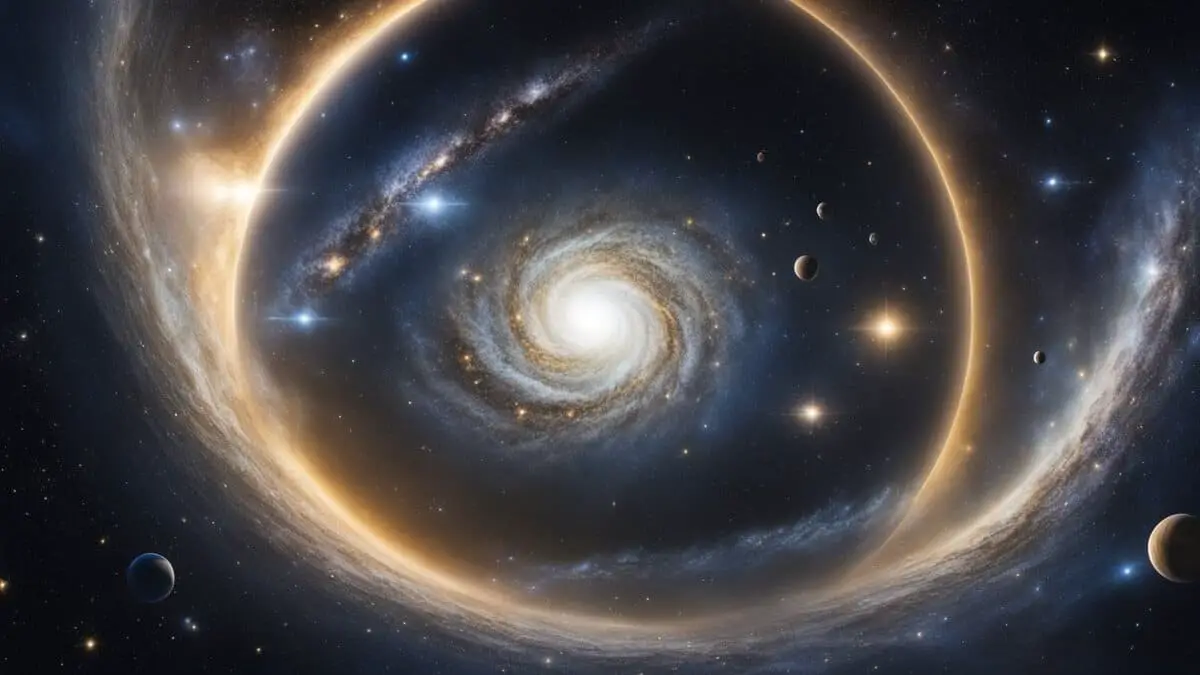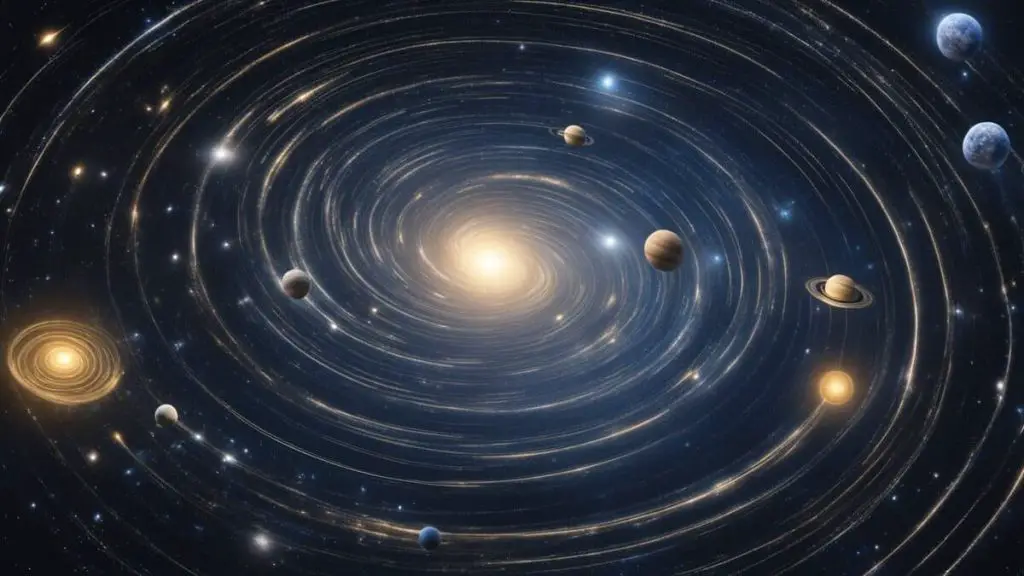You’re curious about the number of solar systems in the Milky Way. Curiosity about our galaxy’s scale is natural. With its vast expanse, the Milky Way prompts a fundamental question: How many solar systems does it contain?
This question is more complex than it seems. The sheer size and complexity of the Milky Way make estimating the number of solar systems challenging. With billions of stars, counting every potential solar system is daunting.
This article provides the insights you need. I’ve crafted a comprehensive exploration of the Milky Way’s structure, the lifecycle of stars, and the potential for life beyond Earth. You’ll find clear, engaging answers to your questions and more.
Key Things to Know:
- The Milky Way contains billions of planetary systems, each potentially harboring unique solar systems.
- Stars and their life cycles play a critical role in forming solar systems.
- Space exploration and telescope advancements have expanded our understanding of the galaxy’s vastness.
Recommended For You
Overview: How Many Solar Systems in the Milky Way?

How many solar systems are there in our Milky Way? In my years of stargazing, I’ve often pondered the same question.
FREE STARGAZING CHECKLIST
My 5-page Stargazing Checklist will enhance your astronomical observations.
Follow this free checklist to navigate the night sky with confidence, clarity, and a sense of preparedness for a rewarding stargazing experience.

It’s a significant number, and to understand it, let’s look at the galaxy‘s form and the places stars like ours are most often found.
Galactic Structure and Composition
The Milky Way is like a massive city with different neighborhoods. My experiences with my telescope have shown me the diversity of these cosmic neighborhoods.
Each part of this city has a role:
- Disk: You live in a flat area with many stars and planets, including our solar system.
- Bulge: The center is a busy place with old stars tightly packed together.
- Halo: Around the edges, there’s a less crowded space with some stars and lots of dark matter, like the city’s outskirts.
Spiral Arms and the Galactic Center
The Milky Way has curvy streets known as spiral arms, with gas, dust, and new stars. I’ve captured images of these spiral arms, revealing their stunning beauty and complexity. Right at the heart of our galaxy is a supermassive black hole.
Here’s the scoop:
- Spiral Arms: This is where solar systems are usually born and where you’ll find our solar system.
- Galactic Center: It’s super busy here, and a giant black hole is holding it all together.
Astronomers have found more than 3,200 stars with planets that could have their solar systems just like ours. Each discovery excites me as much as the last, confirming the vast potential for life beyond Earth. But remember, there are probably way more still waiting to be found. You can learn about some discoveries at NASA.
The Solar System and Its Neighbors

In exploring the vast reaches of space, your backyard—the Milky Way—houses an extraordinary variety of star systems, including the one you call home.
Characteristics of Our Solar System
I’ve spent countless nights observing our solar system’s celestial objects, dominated by the Sun, which holds everything in its gravitational grip.
Here’s what makes it special:
- The Sun: The heart of your solar system, providing the light and heat that sustain life on Earth. I’ve observed solar flares and sunspots, marveling at the Sun’s power up close.
- Planets: Major players like Jupiter and Saturn show off their size, while Earth supports life.
- Dwarf Planets: Pluto may not be a full-fledged planet anymore, but it’s an integral part of the family.
- Exoplanets: These are planets outside our solar system. Some, like those in the Trappist-1 system, have piqued interest in the search for life.
Local Group and Nearby Galaxies
Our solar system is just one of many in the Milky Way galaxy, part of an even larger cosmic neighborhood called the Local Group.
Here’s a quick look at our cosmic surroundings:
- The Milky Way Galaxy: Your galactic home, with possibly billions of other planetary systems.
- The Local Group: A cluster of over 50 galaxies, including the Milky Way.
- Andromeda Galaxy: The closest spiral galaxy to the Milky Way and on a collision course with it—don’t worry, it’s billions of years away!
Each of these entities—from the familiar Sun and Earth to the far-flung Andromeda Galaxy—plays an integral role in the vast tapestry of the cosmos.
Stars and Stellar Life Cycles

When you look up at the night sky, you see the majesty of countless stars at different stages in their life cycles. Some are just forming, while others have burned out long ago.
Star Formation
Stars begin their life in star clusters, giant clouds of dust and gas. When enough material clumps together, gravity pulls it tighter and begins to heat up.
This is the birth of a new star.
- Energy and heat increase as the mass grows.
- When the temperature gets high enough, nuclear fusion starts.
- The star begins shining by giving off radiation and light.
Types of Stars and Their Evolution
Not all stars are the same. Their mass determines their brightness and lifespan. My observations have taught me the diversity of stars, from dim dwarfs to brilliant supergiants.
- Main-sequence stars: These are stable stars like the Sun, burning hydrogen into helium.
- Red giants: After a while, stars expand and cool to become red giants. They are brighter despite being cooler.
- Supergiants: Some stars become even bigger and brighter giants.
Stars end their lives in different ways:
- Smaller stars fade into white dwarfs.
- Stars with more mass might explode as supernovae and become neutron stars or black holes.
Remember, every star is on its unique journey, and your sun is a star in the prime of its life, stable and bright on the main sequence.
Exploring the Milky Way

Looking at the night sky, you see just a tiny glimpse of the Milky Way. It’s our galactic home, full of mysteries and wonders, and it’s been the focus of countless observations and missions to understand its vastness.
Astronomical Observations and Discoveries
Your adventure through the stars isn’t complete without understanding how astronomers have studied the Milky Way. Using various telescopes, they’ve dug into the secrets hidden in the night sky. My experiences with different telescopes deepened my appreciation for the Milky Way’s secrets.
For example, the constellation Sagittarius is key, as it’s the direction where the center of our galaxy lies. Throughout history, milestones like Edwin Hubble’s study of Cepheid variables and Jan Oort’s observations have expanded our knowledge.
Let’s look at some discoveries:
- Scientists have found more than just stars and planets; they’ve uncovered regions like the Orion Arm, where our solar system sits.
- They’ve also spotted the Monoceros Ring, a stream of stars that wraps around the galaxy.
Space Exploration and Telescopic Advances
Thanks to organizations like NASA and the use of the Hubble Telescope, we’ve been able to peer deeper into space than ever before.
Here’s what they’ve achieved:
- Spacecraft have zoomed past planets, sending back photos and data. I’ve followed these missions closely, each photo and data point fueling my passion for astronomy.
- Telescopes on the ground and in space have given us stunning images of distant galactic features like the Perseus and Sagittarius arms.
They’re not just for professionals, though. Here’s how you can get in on the action:
- Grab a decent telescope and a clear night.
- Find a spot away from city lights.
- Use a star chart to locate the Orion Arm or the constellation Sagittarius.
Remember, exploring the Milky Way is something anyone can enjoy. You need to start looking up!
Life Beyond Earth, our Solar System, and the Milky Way

Finding life beyond Earth is one of the most exciting possibilities in our quest to understand the universe. As we explore our Milky Way galaxy’s vast reaches, we uncover the potential habitats where life might exist.
Search for Extraterrestrial Life
Scientists are busy looking for signs of life outside our planet. You may have heard about Mars, often called our “sister planet,” where missions aim to find water and organic molecules—the building blocks of life. It’s a big deal because Mars could potentially have the right conditions for life as we know it.
Missions like the Mars rovers Spirit, Opportunity, and Curiosity have looked for:
- Signs of past water
- Clues of organic compounds
- Environmental conditions that could support life
But it’s not just Mars that’s in the spotlight. Exoplanets and planets orbiting stars beyond our sun also get a lot of attention. Here’s how researchers figure out if these distant worlds might be habitable:
- They look for planets in the “Goldilocks zone,” where it’s not too hot and not too cold for liquid water.
- They use powerful telescopes to search for water vapor, oxygen, and other signs that could point to life in the planet’s atmosphere.
Planetary Systems and Habitability
Our Milky Way is home to billions of planetary systems. Each star might have its own family of planets like our solar system does with its mix of rocky planets and gas giants.
Here’s where scientists think life has the best shot:
- Planets with rocky surfaces like Earth because they could have water and the right conditions for life
- Moons of gas giants, where beneath icy surfaces, oceans could exist
Rogue planets float through the galaxy without a star and are more of a long shot. You never know—life could surprise us. Scientists factor in all sorts of things when guessing where life might pop up:
- How far the planet is from its star
- What kind of star the planet orbits
- If the planet has an atmosphere that could protect life and keep things cozy
The field of astrobiology is the science where all this searching happens. It combines biology, chemistry, geology, and astronomy to examine the big question: Are we alone? It’s a tough job, but every discovery gets us closer to the answer.
Gravitational Forces and Stellar Dynamics

In this section, I’ll guide you through how gravity shapes the motion and structure of the cosmos. You’ll learn about the rules governing celestial body movement and their complex dances through space.
Understanding Gravity in the Cosmos
Gravity is like the invisible strings that hold the stars and planets in their cosmic dance.
Gravity is the force that:
- Draws objects with mass toward each other
- Keeps planets orbiting around stars
Every bit of matter in the galaxy, from tiny asteroids to supermassive black holes, feels this pull.
Movement and Interaction of Celestial Bodies
The motion through the galaxy is a ballet choreographed by gravity.
Here’s the rundown on how celestial bodies move:
- Stars and planets follow paths called orbits.
- These orbits are usually elliptical, shaped by the mass and gravity of nearby objects.
- Collisions can happen when these paths cross, creating new cosmic architecture.
Remember, gravity is the unseen hero in the galaxy’s story, ensuring each star and planet plays its part.
Frequently Asked Questions
How can I start observing the Milky Way with a basic telescope?
Aim your telescope towards a clear, dark sky away from city lights to start observing the Milky Way with a basic telescope. Focus on areas like the Orion Arm or Sagittarius constellation to glimpse our galaxy’s structure and star clusters.
What are the best conditions for stargazing and observing the Milky Way?
The best conditions for stargazing and observing the Milky Way include a new moon night, away from urban light pollution, and during the summer months in the Northern Hemisphere when the galaxy’s core is visible.
How do astronomers estimate the number of solar systems in the Milky Way?
Astronomers estimate the number of solar systems in the Milky Way by studying star density, observing exoplanets, and using statistical models to infer the presence of solar systems around stars similar to our Sun. These methods help scientists gauge the galaxy’s vast potential for habitable worlds.
TL;DR
- The Milky Way contains billions of planetary systems, each with the potential to harbor unique solar systems.
- Stars play a crucial role in the formation and diversity of solar systems through their life cycles.
- Recent advancements in space exploration and telescopic technology have significantly expanded our knowledge of the galaxy.
- Observing the Milky Way and its celestial bodies provides insights into the potential for life beyond Earth.
- The quest for understanding the Milky Way involves studying its structure, the lifecycle of stars, and the search for extraterrestrial life.
Your curiosity fuels my passion for astronomy, and I’m here to share my journey of discovery with you. Whether you have questions, insights, or a spark of interest, I welcome your thoughts in the comments below. Let’s explore the cosmos together!
Read my other articles in my Milky Way series:
- Can You See the Milky Way with a Half Moon?
- When is Milky Way Season?
- Why Does the Milky Way Look Cloudy?
- Are all the stars we see in the Milky Way?
- Does the Milky Way orbit anything?
- Are the constellations in the Milky Way?
- How are Milky Way pictures taken?
- Can you see the Milky Way with a full moon?
- Can you see the Milky Way on a cruise?
- Can I See the Milky Way with My Eyes?




